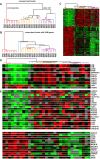CD 9 and vimentin distinguish clear cell from chromophobe renal cell carcinoma
- PMID: 19922654
- PMCID: PMC2788570
- DOI: 10.1186/1472-6890-9-9
CD 9 and vimentin distinguish clear cell from chromophobe renal cell carcinoma
Abstract
Background: Clear cell renal cell carcinoma (ccRCC) and chromophobe renal cell carcinoma (chRCC) can usually be distinguished by histologic characteristics. Occasionally, diagnosis proves challenging and diagnostic difficulty will likely increase as needle biopsies of renal lesions become more common.
Methods: To identify markers that aid in differentiating ccRCC from chRCC, we used gene expression profiles to identify candidate markers that correlate with histology. 39 antisera and antibodies, including 35 for transcripts identified from gene expression profiling, were evaluated. Promising markers were tested on a tissue microarray (TMA) containing 428 renal neoplasms. Strength of staining of each core on the TMA was formally scored and the distribution of staining across different types of renal neoplasms was analyzed.
Results: Based on results from initial immunohistochemical staining of multitissue titer arrays, 23 of the antisera and antibodies were selected for staining of the TMA. For 7 of these markers, strength of staining of each core on the TMA was formally scored. Vimentin (positive in ccRCC) and CD9 (positive in chRCC) best distinguished ccRCC from chRCC. The combination of vimentin negativity and CD9 positivity was found to distinguish chRCC from ccRCC with a sensitivity of 100.0% and a specificity of 95.2%.
Conclusion: Based on gene expression analysis, we identify CD9 and vimentin as candidate markers for distinguishing between ccRCC and chRCC. In difficult cases and particularly when the amount of diagnostic tissue is limited, vimentin and CD9 staining could serve as a useful adjunct in the differential diagnosis of ccRCC and chRCC.
Figures


Similar articles
-
Diagnostic utility of vimentin, CD117, cytokeratin-7 and caveolin-1 in differentiation between clear cell renal cell carcinoma, chromophobe renal cell carcinoma and oncocytoma.J Microsc Ultrastruct. 2017 Apr-Jun;5(2):90-96. doi: 10.1016/j.jmau.2016.07.005. Epub 2016 Jul 26. J Microsc Ultrastruct. 2017. PMID: 30023241 Free PMC article.
-
DOG1, cyclin D1, CK7, CD117 and vimentin are useful immunohistochemical markers in distinguishing chromophobe renal cell carcinoma from clear cell renal cell carcinoma and renal oncocytoma.Pathol Res Pract. 2015 Apr;211(4):303-7. doi: 10.1016/j.prp.2014.12.014. Epub 2014 Dec 30. Pathol Res Pract. 2015. PMID: 25596994
-
HNF1β and S100A1 are useful biomarkers for distinguishing renal oncocytoma and chromophobe renal cell carcinoma in FNA and core needle biopsies.Cancer Cytopathol. 2015 May;123(5):298-305. doi: 10.1002/cncy.21530. Epub 2015 Mar 4. Cancer Cytopathol. 2015. PMID: 25739652
-
Does chromophobe renal cell carcinoma have better survival than clear cell renal cell carcinoma? A clinical-based cohort study and meta-analysis.Int Urol Nephrol. 2016 Feb;48(2):191-9. doi: 10.1007/s11255-015-1161-3. Epub 2015 Nov 20. Int Urol Nephrol. 2016. PMID: 26589610 Review.
-
[Oncocytoma versus chromophobe renal cell carcinoma: Is there something in between?].Pathologe. 2016 Mar;37(2):153-8. doi: 10.1007/s00292-016-0145-0. Pathologe. 2016. PMID: 26925847 Review. German.
Cited by
-
Selected tumor markers in the routine diagnosis of chromophobe renal cell carcinoma.Arch Med Sci. 2016 Aug 1;12(4):856-63. doi: 10.5114/aoms.2015.51188. Epub 2016 Mar 4. Arch Med Sci. 2016. PMID: 27478468 Free PMC article.
-
Linneg Sca-1high CD49fhigh prostate cancer cells derived from the Hi-Myc mouse model are tumor-initiating cells with basal-epithelial characteristics and differentiation potential in vitro and in vivo.Oncotarget. 2016 May 3;7(18):25194-207. doi: 10.18632/oncotarget.7535. Oncotarget. 2016. PMID: 26910370 Free PMC article.
-
Genomics of chromophobe renal cell carcinoma: implications from a rare tumor for pan-cancer studies.Oncoscience. 2015 Feb 20;2(2):81-90. doi: 10.18632/oncoscience.130. eCollection 2015. Oncoscience. 2015. PMID: 25859550 Free PMC article. Review.
-
Hypoxia negatively regulates heparan sulfatase 2 expression in renal cancer cell lines.Mol Carcinog. 2012 Jul;51(7):565-75. doi: 10.1002/mc.20824. Epub 2011 Jul 7. Mol Carcinog. 2012. PMID: 21739484 Free PMC article.
-
AMEND 2.0: module identification and multi-omic data integration with multiplex-heterogeneous graphs.BMC Bioinformatics. 2025 Feb 5;26(1):39. doi: 10.1186/s12859-025-06063-x. BMC Bioinformatics. 2025. PMID: 39910456 Free PMC article.
References
-
- Ries LAG, Melbert D, Krapcho M, Stinchcomb DG, Howlader N, Horner MJ, Mariotto A, Miller BA, Feuer EJ, Altekruse SF, Eds. SEER Cancer Statistics Review, 1975-2005. Bethseda, MD: National Cancer Institute; 2008.
-
- Eble JN, Sauter G, Epstein JI, Sesterhenn IA, Eds. Pathology and Genetics of Tumours of the Urinary System and Male Genital Organs. Lyons: IARC Press; 2004.
-
- Dimarco DS, Lohse CM, Zincke H, Cheville JC, Blute ML. Long-term survival of patients with unilateral sporadic multifocal renal cell carcinoma according to histologic subtype compared with patients with solitary tumors after radical nephrectomy. Urology. 2004;64:462–467. doi: 10.1016/j.urology.2004.04.016. - DOI - PubMed
LinkOut - more resources
Full Text Sources
Other Literature Sources

